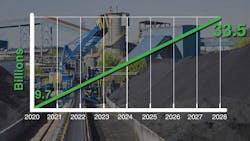We’ve heard it now for more than a decade: Everything is going smart—from homes to cities to manufacturing enterprises. And when it comes to health and safety, going smart isn’t just a fad: It’s a necessity. In industries like mining, autonomous technology will propel safety and efficiency efforts.
In a market report released by Verified Market Research, the global smart mining solutions market was valued at $9.75 billion in 2020 and is expected to hit $33.35 billion by 2028, growing at a CAGR of 16% over the next seven years.
The continuous growth of construction and shipbuilding industries in the Asia Pacific are expected to boost the demand for metals and minerals.
A rise in demand for durable goods—such as vehicles and household items that contain a high amount of mineral or metal—are anticipated to fuel the demand for those substances, which will in turn create more waste from the mining equipment and process. Environmental concerns over waste retrieval and disposal will boost the adoption of autonomous systems.
With an increase in demand for metal and mineral comes the need for faster, more reliable systems due to the cost of operations. Data analysis solutions will enable mining companies to make data decisions and create more throughput.
On the other hand, the lack of a skilled workforce will continue to plague the industry. As older workers retire, there are not enough younger ones to replace them. This makes autonomous mining operations even more crucial to sustain the future of the industry and to keep remaining workers safe.
Some examples of smart equipment include:
- Excavators
- Robotic trucks and systems
- Sensors
- FID tags
- Logistics software
- Operation management software
- Security systems
- Systems integration services
Some major players in the market are Hitachi Construction Machinery, ABB, Komatsu, Metso Outotec, Copco, Caterpillar, Cisco Systems and Alcatel-Lucent.
About the Author

Marie Darty
Group Multimedia Director, Engineering & Manufacturing
Marie Darty is a digital media professional currently serving as the group multimedia director for the Manufacturing & Engineering Group at Endeavor Business Media. A graduate of Jacksonville State University, she earned her Bachelor of Arts in digital communication with a concentration in digital journalism in December 2016. In her current role, she leads the strategy and production of multimedia content, overseeing video series planning and editing. Additionally, she oversees podcast production and marketing of multimedia content.
